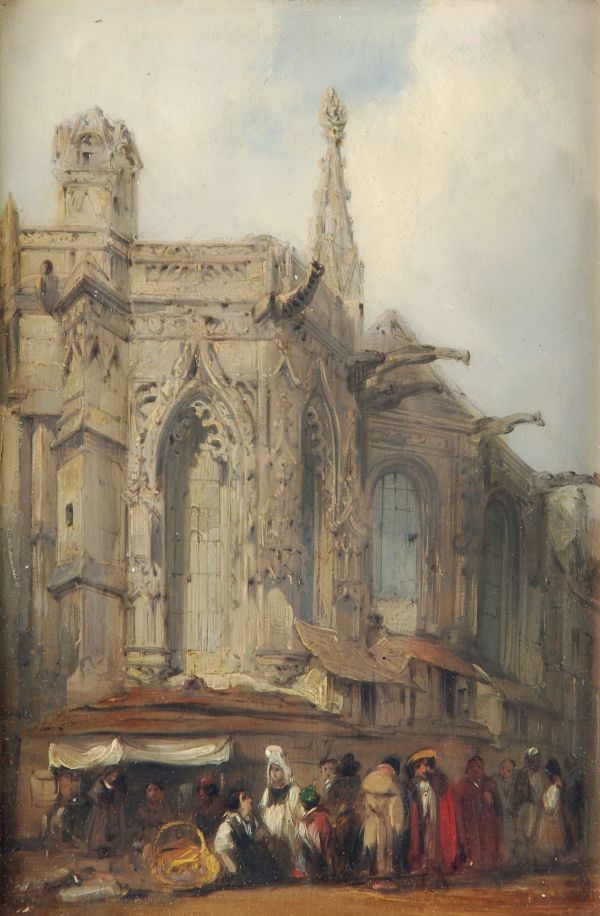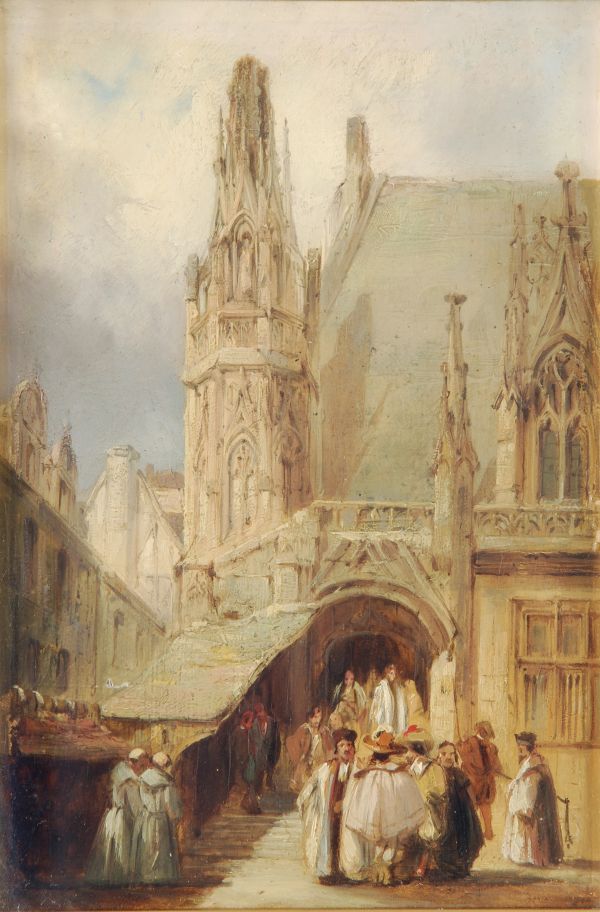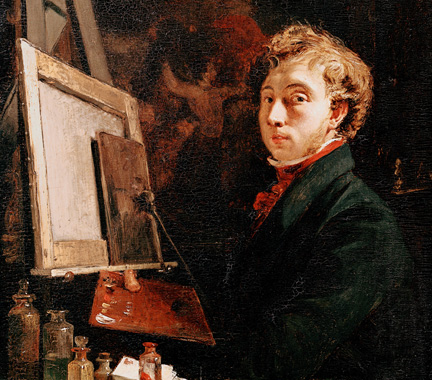 |
Exhibition
|
 |
Exhibition
|
Here, in the Exhibition on Line, we intend to show complete sets of fine prints: small thematic collections, albums of special interest, or related works, with some general remarks as to their creation and their importance.
This space will be renewed regularly, with the previous exhibitions accessible thereafter in the Archives.
The present exhibition concerns a pendant pair of small oil
sketches on oak panels representing two of the monuments that Richard Parkes Bonington studied during his visits to
Normandy in the early 1820s:
 |
 |
| Eglise Saint
Sauveur, Caen |
Entrée de la Salle des Pas Perdus, Palais de Justice, Rouen |
These travels resulted in the landmark
set of
lithographs for his album Restes et Fragmen[t}s
d'Architecture du Moyen Age, published
in 1824, exploring the new medium with a refined graphic treatment.
Furthermore, these pendant pictures are of general interest for several reasons:
Firstly, they attest the Romantic affection for medieval monuments in the tumultuous years following the French Revolution and the Premier Empire, and
Secondly, as Bonington reminisced, 1824 was simply "the happiest year of my
life"*
Though born British (near Nottingham, in 1802), Richard Parkes Bonington moved with his parents to France in 1817, first Calais, and then Paris, where he met Delacroix while studying in the Louvre, and with whom he developed a lasting friendship.
In 1820, he was admitted to the École des Beaux-Arts, working under the Neoclassical painter, Baron
Antoine-Jean Gros.
Disaccord
with his mentor led him to abandon Paris in 1821,
and explore provincial life on his first trip
to Normandy. He commited himself to the new style of painting après
nature, a more spontaneous and unrestrained style, executed with an alert hand and a keen eye, prefiguring the
Barbizon school and Corot.
He was soon quite well known, not only in artistic circles, and even exhibited his first paintings at the Salon de Paris in 1822.
He died too
young, at the age of 25, though he left a lasting impression:
Such a perspicacious eulogy is simply remarkable!
Furthermore,
Corot later recalled the revelation — upon seeing a Bonington
watercolour in a shop window — that made him decide to become a
painter.
Most importantly his works are now rated among the masterpieces of the early 19th century, on a par with those of Turner, for example...

Richard Parkes Bonington
(1802-1828)
was a major
figure in the emergence of Romantic art and a source of inspiration for
many of his contemporaries, as well as a considerable number of followers.
His vision may be seen in part as a reaction to the dominant Academism and Neoclassicism of the period:
- a marked interest in to the "lower" genres (landscapes and
architecture), as opposed to the grand genre of history and allegorical painting;
- a deft rendering of atmosphere
that was truly innovative, working en pleine air
to
capture the fleeting effects of light across expanses of sky and buildings, enlivened by small figures
attending to their everyday affairs;
- a clear predilection for small formats (such as may be seen on the easel in his self-portrait, right).
The album of 10 lithographs, Restes et Fragmen[t]s
d'Architecture du Moyen Age, which he published in 1824 to realize this
vision (and to meet the public demand for his work), was his
most
accomplished graphic undertaking. Most of these lithographs are derived from
his Norman travels. (See A. Curtis, Catalogue
de l'oeuvre lithographié et gravé de R. P. Bonington,
Paris,
1939 for a full description of these prints.)
We unfortunately have few examples of his preparatory works for these prints (see P. Noon, Richard Parkes Bonington, the Complete Paintings, New Haven, 2008), which makes these oil sketches all the more important.
Furthermore, Romantic interest in the architecture of the Middle Ages was a clear break from Neoclassical
canons, which held Graeco-Roman Antiquity in the highest regard, while
dismissing medieval art as Gothic, i.e. the "barbarous German style" as
defined by Vasari centuries before.
Normandy
is of course named for the Norsemen who raided and colonized the
northwest coast
of France. Properly speaking though, Normandy was first founded
by
Rollo, a Viking jarl, who had invaded in the lower Seine valley and
even beleaguered Paris.
In 911 AD, by treaty with Charles the Simple, king of Western Francia, Rollo pledged to him feudal allegiance, and converted to Christianity; in exchange, all the land between the Epte and the sea (i.e., the lower Seine basin) was ceded to Rollo. He established Rouen as his de facto capital.
Normandy became a duchy per se in the late 10th century, and Caen became a second capital as the Normans expanded westward. Here, William the Conqueror built his immense castle around 1060, founding two abbeys shortly thereafter. Its churches were already remarkable in the early 11th century.
The Duchy of
Normandy, the capital of which was first established at Rouen in
912, made up the heartland of the Anglo-Norman realm until 1204,
when it became part of the royal demesne under Philip II of
France. Philip brought in French administrators, and built the
château to affirm his power,but the judicial system was maintained
under the authority of Norman law; the Norman
Charter of 1315 stipulated that judgements passed in the Exchequer at
Rouen were supreme and could not be overturned by Paris.
The Exchequer of Normandy was thus the sovereign judicial court of assize, but which only convened occasionally; it was transformed into a permanent court of justice during the états généraux of Normandy in 1498, which in 1515 took the name of Parlement de Normandie. This period corresponded to the first phase of construction between 1499-1508.
During the Revolution, Rouen lost its
status as a seat of Parlement, the sovereign court was abolished, and the building
itself was severely damaged.
In Bonington's time, the Palais de Justice was transformed into a royal court of law (1814/1815 - 1848), yet the specificities of Norman law and its practice, embodied in the Parlement de Rouen, perdured into the 19th century.
The Salle des Pas Perdus was specifically the large central lobby of a tribunal, with sufficient space to meet and transact business for legal matters:
- Eugène Viollet-le-Duc, Entretiens sur l’architecture (1872, page 122)
The meaning of the name itself
(literally Hall of Lost Steps) referred to the time spent in pacing the
floor while awating an audience. It obviously inspired Bonington's rich imagination, as we shall see...
The Eglise
Saint Sauveur in Caen is a curious mix of Gothic and Renaissance styles,
with a double nave.
The Eglise Saint Sauveur was founded according to legend by Saint Regnobert, the bishop of Bayeux, in the 7th century; nothing however remains of the early Romanesque structures. The present church was the result of three phases of construction:
The belltower and the easternmost nave, devoted to Saint Eustace (Saint Eustache), were constructed in the 14th century.
In the 15th century, the building was transformed into a hall church ("église-halle" like the German Gothic Hallenkirche),
with an adjoining nave of similar proportions, that extends into a
three-sided apse with large bay windows. A broad ogival arch, 16m
across, was built to integrate the new apse.
Let's take a closer look...
Follow the links below for each of the pictures:
* See Albert Dubuisson & C. E. Hughes, Richard Parkes Bonington : his Life and Work, The Bodly Head, London, 1924, page 51; see also Marcia Pointon, The Bonington Circle: English Watercolour and Anglo-French Landscape, 1790-1855, The Hendon Press, 1985.